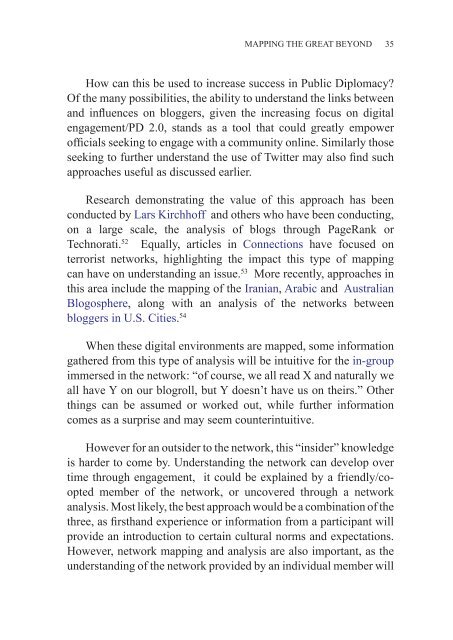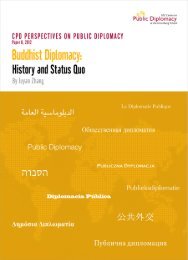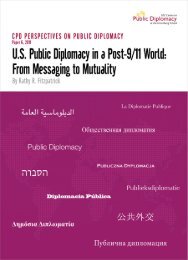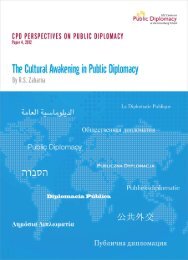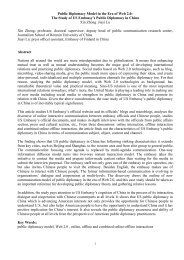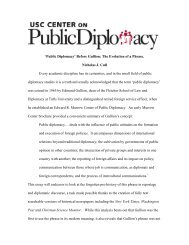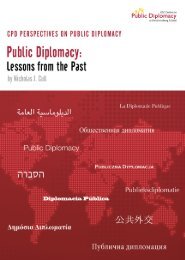Mapping the Great Beyond: Identifying Meaningful Networks in
Mapping the Great Beyond: Identifying Meaningful Networks in
Mapping the Great Beyond: Identifying Meaningful Networks in
You also want an ePaper? Increase the reach of your titles
YUMPU automatically turns print PDFs into web optimized ePapers that Google loves.
MAPPING THE GREAT BEYOND 35<br />
How can this be used to <strong>in</strong>crease success <strong>in</strong> Public Diplomacy?<br />
Of <strong>the</strong> many possibilities, <strong>the</strong> ability to understand <strong>the</strong> l<strong>in</strong>ks between<br />
and <strong>in</strong>fluences on bloggers, given <strong>the</strong> <strong>in</strong>creas<strong>in</strong>g focus on digital<br />
engagement/PD 2.0, stands as a tool that could greatly empower<br />
officials seek<strong>in</strong>g to engage with a community onl<strong>in</strong>e. Similarly those<br />
seek<strong>in</strong>g to fur<strong>the</strong>r understand <strong>the</strong> use of Twitter may also f<strong>in</strong>d such<br />
approaches useful as discussed earlier.<br />
Research demonstrat<strong>in</strong>g <strong>the</strong> value of this approach has been<br />
conducted by Lars Kirchhoff and o<strong>the</strong>rs who have been conduct<strong>in</strong>g,<br />
on a large scale, <strong>the</strong> analysis of blogs through PageRank or<br />
Technorati. 52 Equally, articles <strong>in</strong> Connections have focused on<br />
terrorist networks, highlight<strong>in</strong>g <strong>the</strong> impact this type of mapp<strong>in</strong>g<br />
can have on understand<strong>in</strong>g an issue. 53 More recently, approaches <strong>in</strong><br />
this area <strong>in</strong>clude <strong>the</strong> mapp<strong>in</strong>g of <strong>the</strong> Iranian, Arabic and Australian<br />
Blogosphere, along with an analysis of <strong>the</strong> networks between<br />
bloggers <strong>in</strong> U.S. Cities. 54<br />
When <strong>the</strong>se digital environments are mapped, some <strong>in</strong>formation<br />
ga<strong>the</strong>red from this type of analysis will be <strong>in</strong>tuitive for <strong>the</strong> <strong>in</strong>-group<br />
immersed <strong>in</strong> <strong>the</strong> network: “of course, we all read X and naturally we<br />
all have Y on our blogroll, but Y doesn’t have us on <strong>the</strong>irs.” O<strong>the</strong>r<br />
th<strong>in</strong>gs can be assumed or worked out, while fur<strong>the</strong>r <strong>in</strong>formation<br />
comes as a surprise and may seem counter<strong>in</strong>tuitive.<br />
However for an outsider to <strong>the</strong> network, this “<strong>in</strong>sider” knowledge<br />
is harder to come by. Understand<strong>in</strong>g <strong>the</strong> network can develop over<br />
time through engagement, it could be expla<strong>in</strong>ed by a friendly/coopted<br />
member of <strong>the</strong> network, or uncovered through a network<br />
analysis. Most likely, <strong>the</strong> best approach would be a comb<strong>in</strong>ation of <strong>the</strong><br />
three, as firsthand experience or <strong>in</strong>formation from a participant will<br />
provide an <strong>in</strong>troduction to certa<strong>in</strong> cultural norms and expectations.<br />
However, network mapp<strong>in</strong>g and analysis are also important, as <strong>the</strong><br />
understand<strong>in</strong>g of <strong>the</strong> network provided by an <strong>in</strong>dividual member will


